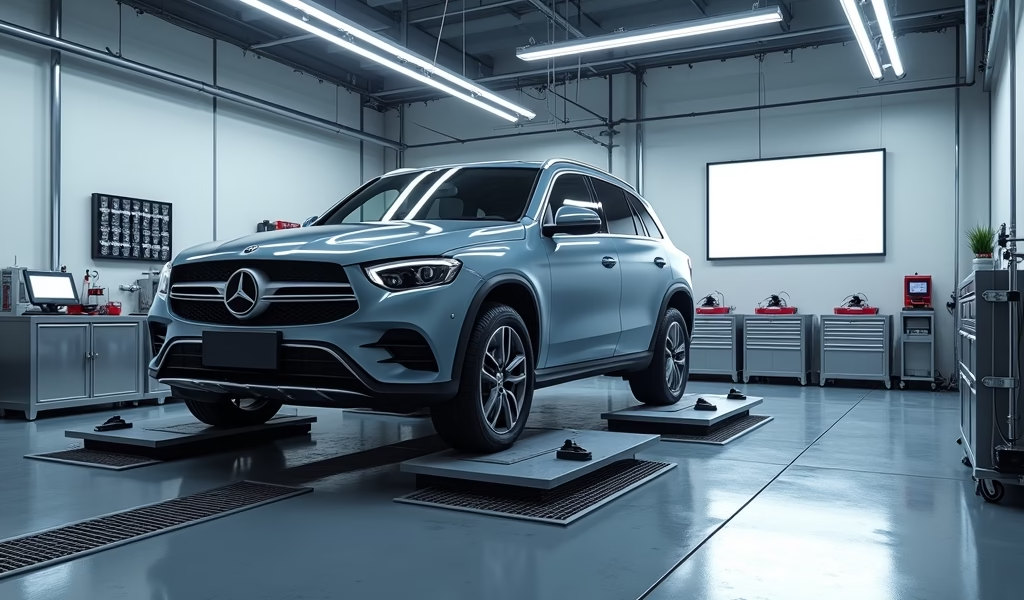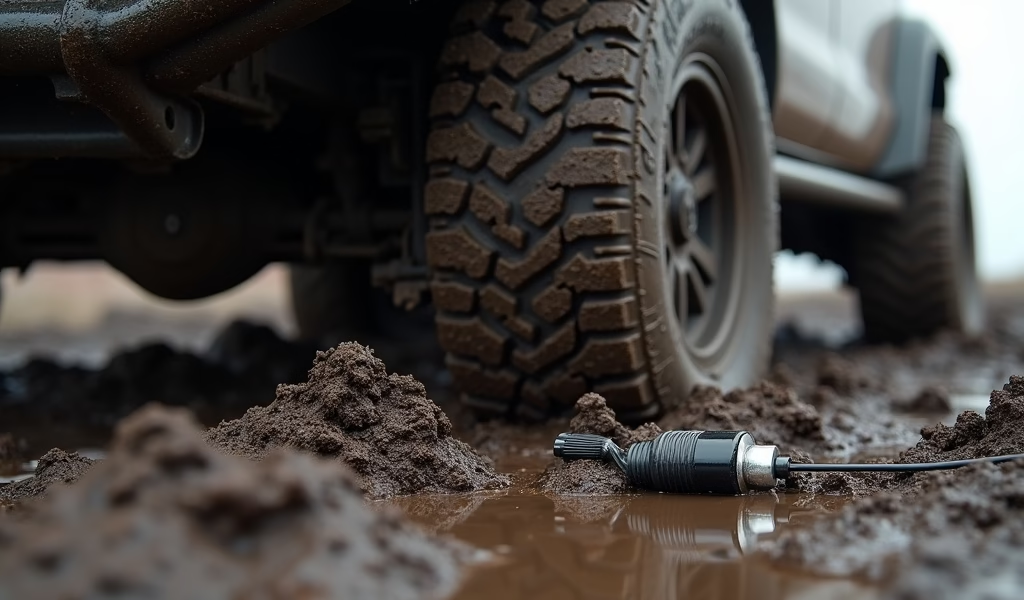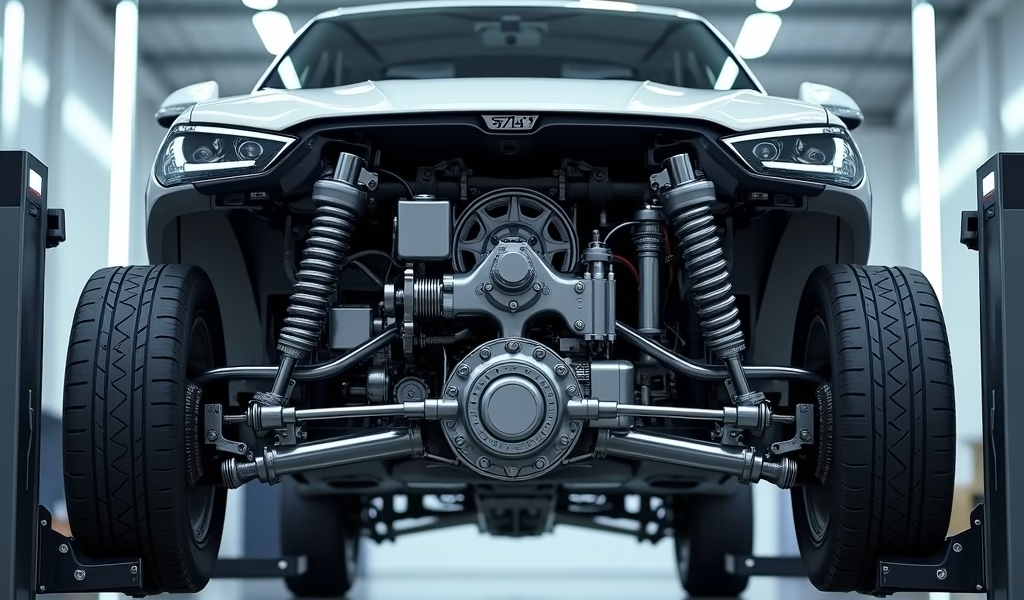Overview
This article explains how proper AWD system calibration is crucial for vehicle safety, performance, and longevity, detailing symptoms of miscalibration, maintenance practices, and the calibration process while comparing DIY versus professional services. It also explores emerging technologies in AWD systems, including self-calibrating mechanisms, AI integration, and cloud connectivity that will transform how these systems operate in the future.
Table of Contents
- Understanding All Wheel Drive Systems: The Basics
- The Importance of Proper Calibration
- Signs Your AWD System Needs Calibration
- The Calibration Process Explained
- DIY Calibration vs. Professional Service
- Maintenance Tips for Optimal AWD Performance
- Future Technologies in AWD Calibration
- Conclusion
- Frequently Asked Questions
Understanding All Wheel Drive Systems: The Basics
Picture this: you’re navigating through a treacherous mountain pass as rain transitions to sleet, and suddenly, your vehicle maintains perfect traction where others might slip. That’s the magic of a properly calibrated all wheel drive system working its wonders. Like a well-orchestrated symphony, each component plays its part to deliver power precisely where and when it’s needed.
All wheel drive (AWD) systems have evolved dramatically since their introduction. Gone are the days of clunky, fuel-guzzling mechanisms that only engaged when you were already stuck in mud. Today’s sophisticated AWD setups continuously monitor dozens of inputs—from wheel speed sensors to yaw rate monitors—making split-second decisions that keep you safely on the road.
“The modern AWD system is essentially a computer with wheels,” explains James Halderman, automotive technology educator and author. “It’s processing thousands of calculations per second to determine optimal power distribution.”
But what exactly does an AWD system consist of? At its heart, you’ll find a center differential (or similar power transfer unit), which directs engine torque between the front and rear axles. Depending on the vehicle, this may be supplemented by additional differentials, electronic clutches, or other mechanical wizardry that helps distribute power across all four wheels.
Much like how your smartphone needs occasional updates to function optimally, your AWD system requires proper calibration to interpret sensor data correctly and respond appropriately. This calibration ensures the system can accurately detect wheel slip, vehicle yaw, throttle position, and dozens of other variables that influence driving dynamics.
The Importance of Proper Calibration
Have you ever worn a pair of shoes that were just slightly the wrong size? They might seem fine at first, but over time, you notice discomfort, inefficiency, and potential harm. That’s precisely what happens with an uncalibrated AWD system—it functions, but not optimally, potentially causing long-term damage and compromising safety.
Proper all wheel drive system calibration is the unsung hero of vehicle performance. When calibrated correctly, your AWD system delivers enhanced traction on slippery surfaces, improved cornering stability, and better overall handling. It’s the difference between confidently navigating that rain-slicked highway and white-knuckling the steering wheel at every curve.
Beyond the immediate safety benefits, calibration directly impacts your vehicle’s longevity. An uncalibrated system might unnecessarily engage AWD components, creating excess heat and wear. This premature wear doesn’t just affect the AWD components—it can cascade through the entire drivetrain, leading to expensive repairs down the road.
Fuel economy also takes a hit with improper calibration. When sensors misread conditions and the system engages unnecessarily, your engine works harder to overcome the additional resistance from the AWD mechanics. According to research from the Society of Automotive Engineers, proper AWD calibration can improve fuel efficiency by up to 5-7% in certain driving conditions.
Perhaps most compelling is how calibration affects your everyday driving experience. A properly calibrated traction control system working in harmony with your AWD can make the difference between a vehicle that feels responsive and confident versus one that seems hesitant and unpredictable. As driving enthusiasts often say, “It’s not just about getting from A to B—it’s about how the journey feels.”

Signs Your AWD System Needs Calibration
Your vehicle communicates with you more than you might realize. When it comes to AWD calibration issues, your car has a distinctive language of warning signs—if you know what to listen for. Think of these symptoms as your vehicle’s way of raising its hand to say, “I need some attention here!”
The most obvious red flag is an illuminated AWD warning light on your dashboard. This little beacon isn’t just there for decoration—it’s your first line of communication from your vehicle’s onboard diagnostics. When it lights up, it’s essentially saying, “Hey, something’s not right with the AWD system.”
Notice unusual vibrations or shuddering during acceleration? That’s another telltale sign. Properly calibrated AWD systems engage smoothly, almost imperceptibly. If your vehicle feels like it’s doing the rumba when you press the gas, calibration issues may be to blame. These vibrations typically occur between 15-40 mph during light to moderate acceleration.
Unpredictable handling characteristics should also raise eyebrows. Does your vehicle pull to one side during acceleration? Does it feel unstable during lane changes? These handling quirks often stem from uneven power distribution—a classic symptom of calibration problems.
Pay attention to unusual noises too. Grinding, clunking, or whining sounds—particularly during turns—can indicate that your AWD components aren’t engaging properly due to calibration issues. As certified mechanic Tony Molla notes, “Your ears are sophisticated diagnostic tools. Unusual sounds almost always precede mechanical failures.”
Excessive tire wear patterns tell another important story. Examine your tires carefully. Uneven wear across all four tires—particularly when the front and rear show dramatically different wear patterns—often points to stability control sensor alignment issues that affect AWD calibration.
Finally, watch for decreased fuel efficiency. If you’re suddenly making more frequent trips to the pump without changes in your driving habits, your AWD system might be engaging unnecessarily due to faulty calibration, forcing your engine to work harder and burn more fuel.
The Calibration Process Explained
Let’s pull back the curtain on the calibration process. Imagine a meticulous conductor fine-tuning each instrument in an orchestra until they create perfect harmony—that’s essentially what happens during AWD calibration. The process ensures all sensors, computers, and mechanical components communicate and respond correctly.
Modern calibration typically begins with a sophisticated diagnostic scan. Using specialized equipment that connects to your vehicle’s OBD-II port, technicians access the AWD control module to retrieve error codes and current parameter settings. This digital conversation reveals exactly what the system thinks is happening versus what should be happening.
Next comes sensor verification and alignment. Each wheel speed sensor, yaw rate sensor, accelerometer, and position sensor is checked for accuracy. Even small misalignments can cause big problems—imagine trying to navigate with a compass that’s off by just a few degrees. You might start on course, but you’ll end up miles from your destination!
The heart of the calibration process involves reprogramming the control module with manufacturer-specified parameters. This isn’t simply a matter of resetting to default settings. The technician must consider your specific vehicle’s configuration, tire size, drivetrain components, and even regional driving conditions.
For vehicles with adaptive systems that “learn” driver behavior, the learning parameters must be reset to allow the system to build new reference points. This is similar to how voice recognition software improves over time as it learns your speech patterns.
The calibration process culminates in a road test under varying conditions. During this test, the technician may use real-time monitoring equipment to verify that the AWD system engages appropriately during acceleration, cornering, and on different road surfaces. The system should respond seamlessly, engaging additional wheels when needed and reverting to more efficient modes when extra traction isn’t required.
According to data from leading AWD system manufacturer GKN Automotive, properly calibrated systems can respond to traction changes in less than 100 milliseconds—faster than you can blink! This split-second responsiveness can make all the difference in emergency situations where every fraction of a second counts.
DIY Calibration vs. Professional Service
Should you roll up your sleeves and tackle AWD calibration yourself, or leave it to the pros? This question sparks debates in garages and forums across the country. Like deciding whether to cut your own hair or visit a stylist, the answer depends on your skills, tools, and comfort with risk.
For the DIY enthusiast, basic calibration resets are possible with the right equipment. Entry-level OBD-II scanners with AWD system capabilities start around $150-300—not cheap, but potentially cost-effective if you maintain multiple vehicles. These tools can reset error codes and perform basic calibration resets, similar to restarting your computer when it acts up.
However, comprehensive calibration requires specialized equipment that can cost thousands. Professional-grade tools access manufacturer-specific parameters and perform precision adjustments that consumer-grade scanners simply can’t touch. It’s the difference between tuning a piano by ear versus using professional tuning equipment.
The knowledge gap presents another challenge. Professional technicians undergo extensive training specific to different AWD systems. They understand the intricate dance between mechanical components and electronic controls. As master technician Paul Danner puts it, “Without system-specific knowledge, you’re just guessing—and guessing with AWD systems can get expensive fast.”
Consider the potential for costly mistakes. Incorrect calibration can damage drivetrain components, leading to repairs that dwarf what you would have spent on professional service. It’s like saving money on a DIY electrical project only to burn down your house—the savings quickly become irrelevant.
That said, owners can perform valuable maintenance that supports proper calibration. Maintaining correct tire pressure, rotating tires regularly, and addressing unusual symptoms promptly all contribute to AWD system health. These practices help maintain the foundation upon which good calibration depends.
If you’re considering the DIY route, start small. Learn to read and clear basic error codes. Monitor system parameters during normal driving. Understanding your system’s normal behavior creates a baseline that helps you recognize when something’s amiss. This knowledge makes you a better-informed consumer even if you ultimately choose professional calibration services.

Maintenance Tips for Optimal AWD Performance
Maintaining your AWD system is like nurturing a garden—consistent care yields impressive results. With these practical tips, you can extend the life of your AWD components and postpone the need for recalibration.
First and foremost, tire maintenance reigns supreme. Your AWD system calculates power distribution based partly on wheel rotation speeds. When tires have different diameters due to uneven wear or pressure, these calculations go haywire. Think of it like trying to walk with one shoe significantly thicker than the other—you’ll develop a limp!
Follow these tire maintenance guidelines religiously:
- Rotate tires every 5,000-7,500 miles to ensure even wear
- Check tire pressure monthly, including the spare
- Replace all four tires simultaneously when needed
- Ensure new tires match the manufacturer’s recommended specifications
Fluid maintenance deserves equal attention. Your roll stability control module works alongside AWD components that rely on proper lubrication. Check transfer case fluid, differential oil, and transmission fluid according to your owner’s manual. These fluids break down over time, losing their protective properties and contributing to sensor inaccuracies.
Be mindful of your driving habits. While AWD systems are designed for versatility, they’re not invincible. Avoid prolonged “stunt driving” behaviors like drifting or aggressive off-roading that can throw off calibration parameters. As one Ford engineer colorfully put it, “AWD gives you better control, not a license to drive like you’re in an action movie.”
Listen for changes in your vehicle’s normal sounds and sensations. Developing a baseline awareness of how your properly functioning AWD system sounds and feels allows you to identify changes early. Early detection often means simpler, less expensive fixes.
Consider seasonal check-ups. Just as you might prepare your home differently for winter and summer, your AWD system benefits from seasonal attention. Before winter, ensure all components are functioning optimally for snow and ice. Before summer road trips, verify the system can handle sustained highway driving without overheating.
Finally, don’t ignore those warning lights! Modern vehicles are equipped with sophisticated diagnostics that detect issues long before they become catastrophic. Addressing warning indicators promptly can prevent cascade failures that affect multiple systems.
Future Technologies in AWD Calibration
The horizon of AWD technology shimmers with innovation. As we peer into the future, the calibration landscape is transforming from reactive maintenance to proactive intelligence. These emerging technologies will revolutionize how we interact with our vehicles’ traction systems.
Self-calibrating AWD systems represent the next evolutionary leap. Instead of requiring periodic professional calibration, these systems continuously monitor performance parameters and make micro-adjustments in real time. Like a self-tuning instrument, they maintain optimal performance without external intervention. Several manufacturers have prototype systems that can detect misalignments and compensate automatically.
Artificial intelligence is revolutionizing calibration by enabling predictive maintenance. Machine learning algorithms analyze patterns in sensor data to identify potential calibration issues before they affect performance. As Dr. Elena Krupitsky from MIT’s Vehicle Dynamics Laboratory explains, “These systems don’t just react to conditions—they anticipate them based on historical data and environmental factors.”
Cloud-connected calibration brings another dimension to AWD performance. Imagine your vehicle receiving calibration updates overnight, much like your smartphone updates its operating system. These updates could optimize your AWD performance based on seasonal changes, regional driving conditions, or even recall information—all without a visit to the dealership.
Integration with vehicle-to-infrastructure (V2I) communications will further enhance calibration. Your AWD system could receive real-time data about road conditions from infrastructure sensors, adjusting calibration parameters before you even encounter slippery surfaces or challenging terrain. This proactive approach could significantly improve safety during changing weather conditions.
For electric vehicles, AWD calibration is taking on entirely new dimensions. With individual motors controlling each wheel, electric AWD systems offer unprecedented precision in power distribution. Calibration for these systems focuses less on mechanical components and more on the algorithms controlling power delivery. The result is AWD performance that can be customized through software alone—think of it as downloading different “AWD personalities” to suit your driving preferences.
As exciting as these advancements are, they also present new challenges. More sophisticated systems mean more complex calibration procedures requiring advanced training and equipment. The industry is responding with augmented reality tools that guide technicians through calibration procedures, displaying real-time instructions overlaid on the actual components they’re working with.
Conclusion
Throughout this journey exploring all wheel drive system calibration, we’ve navigated the complex interplay of mechanical components, electronic sensors, and computer algorithms that make modern AWD systems work their magic. Like a well-choreographed dance, these elements must move in perfect harmony to deliver the performance, safety, and efficiency we expect from our vehicles.
Proper calibration isn’t just a technical nicety—it’s the foundation upon which your AWD system builds its performance. From ensuring responsive handling on rain-slicked roads to maximizing fuel efficiency during your daily commute, calibration touches every aspect of your driving experience.
Remember that your vehicle communicates with you. Those unusual vibrations, warning lights, and handling characteristics aren’t random—they’re specific messages alerting you to potential calibration issues. Heeding these early warnings can save you from costly repairs and compromised safety down the road.
Whether you choose the DIY path or professional service for your calibration needs, knowledge is your best tool. Understanding how your system works and what it needs empowers you to make informed decisions about maintenance and service.
As AWD technology continues to evolve, stay curious about new developments. The self-calibrating, AI-enhanced systems on the horizon promise to make AWD performance even more remarkable—and your role in maintaining it increasingly effortless.
For now, treat your AWD system with the care it deserves. Follow maintenance schedules, pay attention to warning signs, and seek qualified help when needed. Your reward will be a vehicle that performs reliably in all conditions, keeping you and your passengers safe while delivering the driving experience you expect.
After all, in the symphony of automotive technology, a well-calibrated AWD system ensures that every note plays perfectly—even when the road ahead is anything but perfect.
Frequently Asked Questions
How often should I calibrate my AWD system?
Most manufacturers recommend AWD calibration every 30,000 miles or when major components are replaced. However, immediate calibration is necessary if you notice warning lights, unusual noises, or handling issues.
Does tire replacement require AWD recalibration?
Yes, replacing tires often necessitates AWD recalibration, especially if the new tires have different dimensions or tread patterns. Always replace all four tires simultaneously on AWD vehicles to maintain proper system function.
Can I drive with an uncalibrated AWD system?
While possible, driving with an uncalibrated AWD system risks component damage and compromises safety in challenging conditions. Consider it similar to driving with improperly aligned wheels—functional but potentially harmful long-term.
How much does professional AWD calibration typically cost?
Professional AWD calibration generally costs between $150-$400, depending on vehicle make, model, and system complexity. This investment prevents costlier repairs from component damage that might result from continued operation with an uncalibrated system.
Will AWD calibration improve my fuel economy?
Yes, proper calibration can improve fuel economy by ensuring your AWD system engages only when necessary. An uncalibrated system may remain unnecessarily engaged, creating drivetrain drag that increases fuel consumption.

